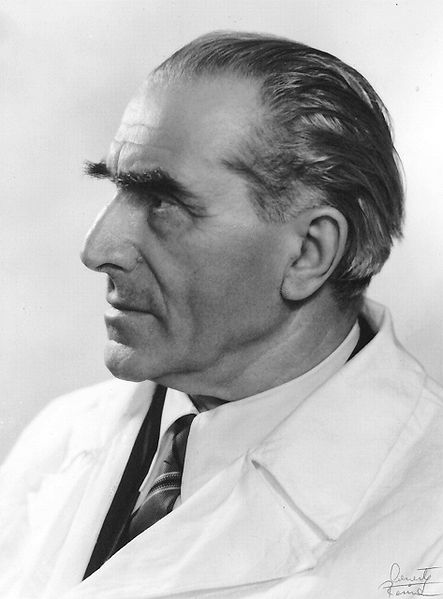<Back to Index>
- Neurologist Ugo Cerletti, 1877
- Poet Thomas Stearns Eliot, 1888
- King of Denmark Christian X, 1870

Ugo Cerletti (September 26, 1877 - July 25, 1963) was an Italian neurologist who discovered the method of electroconvulsive therapy in psychiatry.
He was born in Conegliano, in the region of Veneto, Italy, on September 26, 1877. He studied Medicine at Rome and Turin, later specializing in neurology and neuropsychiatry. He studied with the most eminent neurologists of his time, first in Paris, France, with Pierre Marie and Dupré, then in Munich, Germany, with Emil Kraepelin (the "father" of modern scientific psychiatry) and Alois Alzheimer (the discoverer of the most common form of senile dementia, which today bears his name); and in Heidelberg, with Franz Nissl, a neuropathologist.
After his studies, he was appointed head of the Neurobiological Institute, at the Mental Institute of Milan. In 1924 he was given a lecturing post in Neuropsychiatry in Bari; then, in 1928, he took over the post of Prof. Enrico Morselli, at the University of Genoa. Finally, in 1935, he became the Chair of the Department of Mental and Neurological Diseases at the University of Rome La Sapienza, where he developed electroconvulsive therapy for the treatment of several kinds of mental disorders, a discovery which made him world-famous. Cerletti
came to the first use of electroshock for therapeutic purposes in human
beings by way of his experiments with animals on the neuropathological consequences of repeated epilepsy attacks. In Genoa, and later in Rome, he used an electroshock apparatus to provoke repeatable, reliable epileptic fits in dogs and other animals. The idea to use ECT in humans came first to him by watching pigs being anesthetised with electroshock before being butchered, in Rome. Furthermore, since 1935, metrazol, an epileptogenic drug, and insulin, a hormone, were in wide use in many countries to treat schizophrenics, with great success. This approach was based on Nobel winner Julius Wagner-Jauregg's research on the use of malaria-induced convulsions to treat some nervous and mental disorders, such as the general paresis of the insane, caused by neural syphilis, as well as on Ladislas J. Meduna's
theory that schizophrenia and epilepsy were antagonistic, which
eventually led, in the same period, to institute insulin-coma therapy
in psychiatry, by Manfred Sakel, in 1933. Cerletti first used ECT in a human patient, a diagnosed schizophrenic with delusions, hallucinations and confusion, in April 1938, in collaboration with Lucio Bini.
A series of electroshocks were able to return the patient to a normal
state of mind. Thereafter, in the succeeding years, Cerletti and his
coworkers experimented with thousands of electroshocks in hundreds of
animals and patients, and were able to determine its usefulness and
safety in clinical practice, with several indications, such as in acute
schizophrenia, manic-depressive illness, major depression episodes,
etc. His work was very influential, and ECT quickly spread out as a
therapeutic procedure all over the world. Despite the fact that it does
evoke a grand mal seizure marked by a stereotyped succession of events.
A tetanic muscular contraction, the "electric spasm, is
followed after a latency of seconds by unconsciousness, a high voltage
paroxysmal spike and sharp-wave discharge, and a clonic convulsion.
Upon recovery of consciousness the subject is left with a transient
acute brain syndrome. Acute brain syndrome can be defined as "A sudden
state of severe confusion and rapid changes in brain function,
sometimes associated with hallucinations and hyperactivity, in which
the patient is inaccessible to normal contact. Symptoms may include
inability to concentrate and disorganized thinking evidenced by
rambling, irrelevant, or incoherent speech. There may be a reduced
level of consciousness, sensory misperceptions and illusions,
disturbances of sleep, drowsiness, disorientation to time, place, or
person, and problems with memory," which is to be expected in people
who suffer head injury, and contributes to the 'need' for compulsion to
treatment under law, as people are unwilling to volunteer to such
barbarism. As
a result of his experiments, which took him from the psychiatric
hospital to the abbatoir and the zoologic gardens, Cerletti developed a
theory that ECT caused the brain to produce vitalising substances,
which he called "agro-agonines" (from the Greek for extreme struggle).
He put his theory into practice by injecting patients with a suspension
of electroshocked pig brain, with encouraging results. Although
electroshocked pig brain therapy was used by a few psychiatrists in
Italy, France and Brazil it did not become as popular as ECT, which
soon replaced metrazol therapy all over the world because it was
cheaper, less frightening and more convenient. Cerletti and Bini were nominated for a Nobel Prize but didn't get one. In his long activity as a psychiatrist and neurologist, Cerletti published 113 original papers, about the pathology of senile plaques in Alzheimer's disease, on the structure of neuroglia, the blood-brain barrier, syphilis, etc. In 1950 he received a honorary degree by the Collège de Sorbonne at the University of Paris, in addition to a long list of other awards and degrees. Cerletti died in Rome, on July 25, 1963.